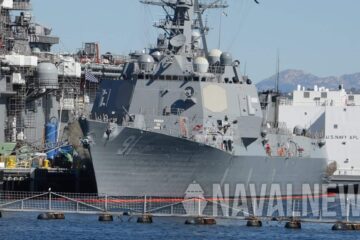By Mass Communication Specialist 1st Class Charlotte Oliver, USS Frank Cable (AS 40) Public Affairs
SAIPAN – The submarine tender USS Frank Cable (AS 40) completed a weapons handling exercise involving the transfer of a MK-48 inert training shape to a submarine, Oct. 22. This was the first expeditionary reload Frank Cable has conducted outside of Guam since 2012.
Working alongside the Los Angeles-class fast attack submarine USS Hampton (SSN 767), Sailors and civil service mariners with Military Sealift Command (MSC) worked together to complete the exercise safely and efficiently.
“This exercise was instrumental to developing the expeditionary combat capabilities that our submarine tenders and submarines bring to the Pacific theater,” said Capt. Albert Alarcon, Frank Cable’s commanding officer. “Every training opportunity helps assure our readiness for any contingency.”
Sailors first transferred the deck skid to Hampton via crane, where it was attached and assembled on the submarine before transferring the MK-48 inert shape. The crew also had to take into account any rocking of the ship and submarine to ensure the transfer went smoothly.
“Due to early and often coordination of this exercise, both Frank Cable and Hampton were able to adapt and safely execute a weapons handling evolution in a new and demanding geographic location,” said Lt. Brandon Shellenberger, Frank Cable’s weapons officer. “The overall execution was great, and everyone demonstrated professionalism and dedication to accomplish the mission.”
For some, it was their first weapons handling evolution working with two different platforms. Still, the crews worked seamlessly with each other.
“Working with Frank Cable’s crew of Navy Sailors and MSC civilian mariners is nostalgic for me, as I recall my first deployment as a junior officer on USS Chicago and mooring outboard Frank Cable in Hong Kong,” said Cmdr. Phillip Sylvia, Jr., Hampton’s commanding officer. “Now in command during my second deployment, Frank Cable continues to provide excellent support for my crew ranging from ordnance, as demonstrated today, to mailing a letter home from their post office. They do it all to support the warfighter.”
The evolution was lengthy. For some, they were able to bring their submarine expertise to an exercise that many Frank Cable Sailors and civil service mariners had yet to experience in their careers.
“This MSC team onboard Frank Cable has always been able to work effortlessly with any Navy detachment to accomplish any goal we are tasked with,” said Torpedoman’s Mate 1st Class Robert Hollister, Frank Cable’s W-1 division leading petty officer.
“Hampton’s weapons department was a very professional and efficient handling team,” Hollister said of working with the submarine Sailors. “My team and I would be glad to work with them again.”
Both crews followed all fleet-mandated COVID protocols with no impact to the exercise.
Frank Cable, forward-deployed to the island of Guam, repairs, rearms, and reprovisions submarines and surface vessels in the Indo-Pacific region. Frank Cable is on patrol conducting expeditionary maintenance and logistics in support of national security in the U.S. 7th Fleet area of operations.
Under Commander, U.S. Pacific Fleet, 7th Fleet is the U.S. Navy’s largest forward-deployed numbered fleet, and routinely interacts and operates with 35 maritime nations in preserving a free and open Indo-Pacific region.
-End-

Naval News comments:
Hampton was laid down in March 1990, launched in April 1992 and commissioned in November 1993. It is homeported at Naval Base Point Loma in San Diego, California. Hampton is the 17th of the Los Angeles-class Flight III or 688i (i for “improved”) design. It features a number of significant improvements over previous boats in the class. 688i subs are quieter and incorporate an advanced AN/BSY-1 sonar suite combat system. Another improvement includes the diving planes moved from the sail down to the hull.
The submarine tender USS Frank Cable (AS 40) departed Guam, as part of a scheduled patrol in the Indo-Pacific region, Oct. 18. The U.S. Navy has two aging 40+ year old Submarine Tenders, USS Emory S. Land (AS 39) and USS Frank Cable (AS 40). Both are forward-deployed and based at Apra Harbor, Guam. They deploy throughout the Indian Ocean and the Western Pacific, repairing U.S. Navy ships and submarines in that theater from Japan to the Persian Gulf. Their ability to reload submarine weapons in coastal waters brings a tactical advantage to the submarine fleet, especially in the Pacific theatre: Submarines don’t need to sail back to base for reloading. However, with only two submarines tenders in operation, this advantage is limited.






